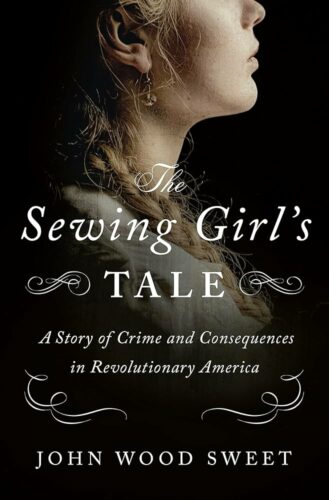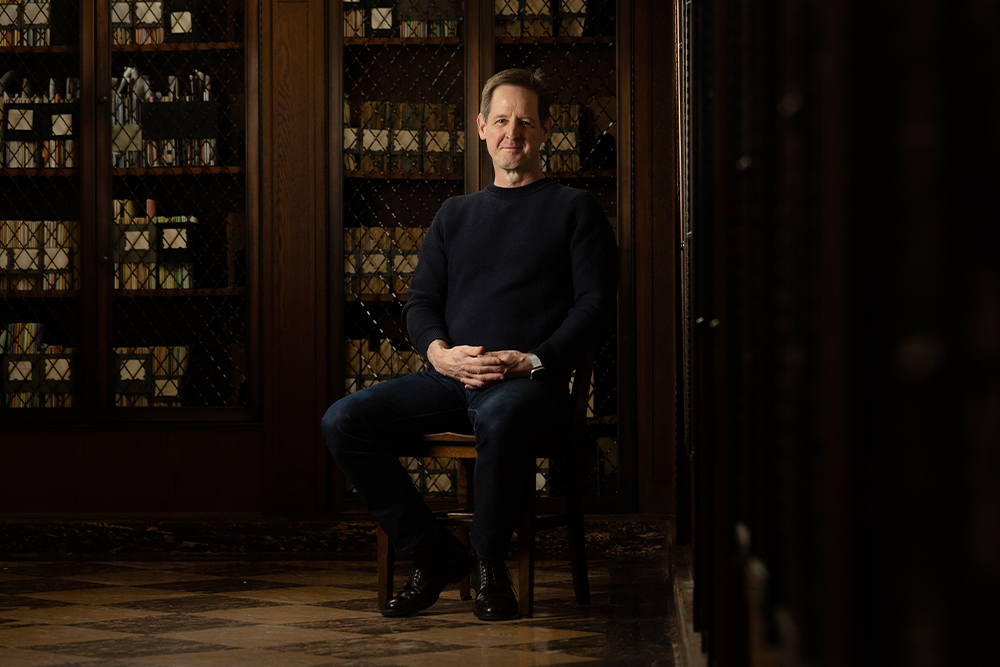Listen to the story:
When asked why he became a historian, UNC-Chapel Hill professor John Wood Sweet says he doesn’t have a good answer.
But then he starts reflecting on his childhood.
He grew up in Concord, Massachusetts, around the corner from Minute Man National Historical Park, which commemorates the start of the American Revolutionary War. It’s where the Battles of Lexington and Concord took place — and the destination of Paul Revere when he made his legendary midnight ride to warn locals that the British army was coming.
Just down the street from Sweet’s childhood home, authors like Ralph Waldo Emerson and Nathaniel Hawthorne wrote some of their most influential works at The Old Manse, and Lousia May Alcott used The Orchard House as her writing space and the setting for “Little Women.”
As a teenager, Sweet worked as a tour guide at these houses and as an assistant in the local library, where he consumed numerous classic historical novels, from “The Three Musketeers” to “The House of Seven Gables.”
“I grew up in a world where books and the past were very present,” he admits.
Here in Chapel Hill, the past remains alive — and thriving — for Sweet. The Carolina historian’s latest book, “The Sewing Girl’s Tale,” received a Bancroft Prize, one of the most distinguished academic awards in the field of history, among numerous other accolades. The book unpacks a legal battle over sexual assault that rocked New York City in the 1790s.
“The Sewing Girl’s Tale” represents Sweet’s first attempt at writing a character-driven historical narrative, and he’s using that experience to continue a project he began years earlier: a biography on Venture Smith, whose 1798 autobiography became the first American slave narrative to be published.
“These two stories have similar writing challenges,” Sweet shares. “Both are emotionally sparse, so you get a lot of action but not a lot of self-reflection and discussion of how people were feeling. As a historian, I’ve had to use available evidence and my imagination to fill out these compelling, emotional stories and make sense of what happened.”
Elevating a woman’s voice in a man’s world
In the late-1980s, as a graduate student at Princeton University, Sweet enrolled in a new class on sex and gender in history. He learned about a famous court trial from 1793, when a seamstress named Lanah Sawyer accused the wealthy Henry Bedlow of rape.
The trial provides testimony from the 17-year-old Sawyer, who felt courted by Bedlow until he forced her into a brothel and took advantage of her. While Sawyer’s case seemed strong, Bedlow’s social status and numerous lawyers — and the extreme tactics they employed — led to a verdict of “not guilty.”
While some of Sweet’s peers used the trial record for their own dissertations and projects, he wouldn’t return to its pages until joining the Carolina faculty in the early 2000s.
Sweet specializes in early American history and colonialism, with a focus on sexuality and gender. Today, he teaches a slew of classes on the topic, like “Sex in American History” — and he uses this case to teach students about the evolution of modern rape culture.
“Students are shocked by how similar this 200-year-old case is to today,” Sweet says. “They see the attempts of the defense to shame the survivor, to slander her, to question her motives. They see how deep the problem is and how longstanding it’s been.”

“The Sewing Girl’s Tale” by John Wood Sweet
Sweet became more interested in Sawyer’s story about 15 years ago, when his graduate student L. Maren Wood found a newspaper article published five years after the trial, claiming Bedlow’s innocence. Upon further exploration, Sweet discovered a series of documents and a letter allegedly written by Lanah Sawyer explaining how she’d wrongly accused Bedlow of rape — but her name was misspelled in the signature.
“The letter was clearly forged,” Sweet explains. “This piece of evidence just blew the case open and raised all these questions about the trial. Over time, I started uncovering more evidence and a sequence of events that was much longer than I had anticipated, more compelling, and more illuminating.”
In response, Sweet began spending lots of time in Manhattan. He dug through piles of property deeds at the Department of Finance, searched for gravesites, visited museums to look at clothing and artifacts, and retraced Sawyer’s steps across the city. He used this information to create an extensive map of 18th-century New York City.
“I wanted people to be able to envision what it looked like walking down the street in Manhattan,” he says. “What is smelled like, what the weather was like, what the textures and views were like.”
For Sweet, “The Sewing Girl’s Tale” was a chance to tell Sawyer’s side of the story — and what it was like to be a young woman in the late-1700s. He pieces this together by analyzing the cultural customs of the time, digging through newspaper clippings and other archival materials, and uncovering the backgrounds of the people involved in the case, including Sawyer’s stepfather and the brothel owner.
He includes examples of other women who found themselves in situations like Sawyer’s to demonstrate how a trial like this could damage her reputation. He even spent a month reading articles and books about suicide to understand what must have gone through Sawyer’s mind as she tried to take her own life after the “not guilty” verdict.
“This was transformative for me,” Sweet says. “To focus on the emotional part of the narrative, I had to push deeper in terms of the kind of research I was doing, and I think that really enriched the story.”
Sweet wanted to know how Sawyer felt when someone showed up and saved her life. Once she recovered, her stepfather — an intimidating figure — told her he wanted to take Bedlow to court again, but this time for a charge of seduction. Pursuing a young woman without the permission of her father was a chargeable offense, and one much more likely to earn Bedlow a “guilty” charge.
While this made a case that should have been about a woman a man’s game, Sweet thinks Sawyer probably felt supported by her family in that moment and that it ultimately helped her move forward.
“Lanah’s relationship with her stepfather was emotionally complicated for me,” Sweet shares. “Even if what he was doing was self-interested, it may have served Lanah’s emotional needs at the same time.”
Bedlow was charged and ultimately sent to debtors’ prison. He unsuccessfully forged the letter from Sawyer as a form of blackmail to influence her family to have him released and, once he did finally get out, would carry it with him to prove his innocence.
Venture-ing into a new world
Compiling Sawyer’s story into a compelling narrative is helping Sweet with a project he’s been working on for the last two decades: a biography on Venture Smith.
When he was about 6 years old, Smith — whose original name was Broteer — was captured during warfare in West Africa and sold into slavery. After surviving a harrowing voyage across the Atlantic, he arrived in New England, where he spent several decades enslaved on large commercial farms. He experienced numerous hardships, including separation from his wife and daughter and failed attempts to purchase his freedom from his enslavers, who would brutally assault him and steal his money.
In roughly 1765, when he was in his mid-30s, Smith successfully purchased his freedom.
While Smith’s autobiography provides much more detail than the court documents detailing just one part of Sawyer’s life — from his childhood in Africa to his enslavement in New England to his struggles to free himself, his wife, and his child — his narrative has gaps. And Sweet has spent the past two decades trying to fill them.
“Venture has a very masculine emotional tenor in his autobiography,” Sweet explains. “He has a sense of honor. He has a sense of outrage. But there’s not a lot of tender emotions. There’s not a lot of vulnerability. And overall, there’s not a lot of emotional self-reflection. So you have to look for the patterns in his life and the tensions that are kind of under the surface.”
To find them, Sweet traveled to archives in England, France, Barbados, and the United States and visited the places Venture Smith lived in both West Africa and New England.
His 2007 trip to West Africa began on the coast of Ghana in Anomabo, where Venture Smith described being held captive before being sold to a Rhode Island slaver. Then, Sweet used clues from Smith’s narrative to retrace his journey from his homeland — across the Atakora Mountains in Togo to the grasslands of northern Benin.
He visited dwellings like the one Smith grew up in, fortified to protect inhabitants from being forcefully removed and sold into slavery. Sweet also watched people herd sheep, a job Smith himself had as a young boy, and talked to locals living in small villages to learn more about their historical traditions and current challenges.
In Connecticut, he explored the various places Smith lived, including a 26-acre farm he bought after becoming free so that he could be close to his still-enslaved wife and children — a site that still contains the foundation of the house he built for himself. Sweet also attended the excavation of Smith’s grave.
“That was fascinating,” he says. “To see the outline of the coffin. The wood had long since disintegrated, but there were nails and a pair of hinges. The fashion of the time was to have a little viewing door so when the body was being displayed people could open the window and see the face.”
Sweet recently signed a contract with a publisher and is now writing the book. He hopes to release it in 2026, during the 250th anniversary of the American Revolution.
While Sawyer and Smith lived incredibly different lives, they each represent a class of people whose stories are often overlooked. This makes uncovering their narratives difficult, but it’s a task that entices Sweet time and time again.
“Lanah Sawyer and Venture Smith were accustomed to being dismissed and disparaged, to being treated as people who didn’t matter. But both, in very unusual and powerful ways, stood up for themselves. Both insisted that they did matter — that in the emerging American nation they, too, belonged. They helped envision an America that would be more inclusive, more just, and more equal.”


